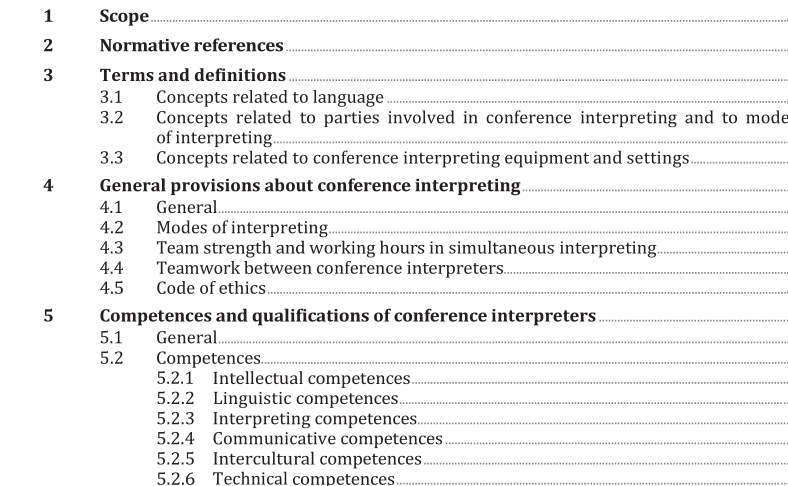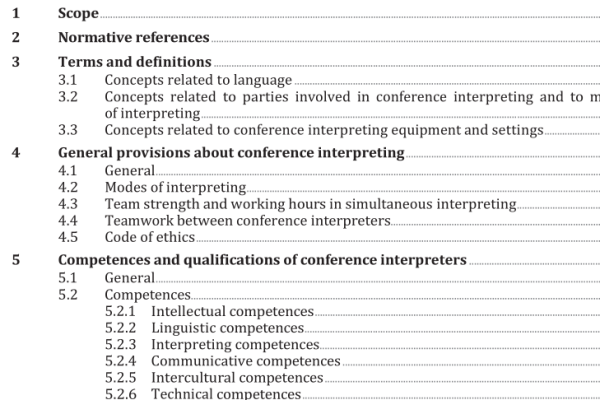ISO 23155:2022 pdf download – Interpreting services — Conference interpreting — Requirements and recommendations.
1 Scope This document specifies requirements and recommendations for the provision of conference interpreting services. It is primarily addressed to conference interpreters and conference interpreting service providers. It also serves as reference for users of conference interpreting services. 2 Normative references There are no normative references in this document. 3 Terms and definitions For the purposes of this document, the following terms and definitions apply. ISO and IEC maintain terminology databases for use in standardization at the following addresses: — ISO Online browsing platform: available at https://www.iso .org/obp — IEC Electropedia: available at https://www.electropedia .org/ 3.1 Concepts related to language 3.1.1 language systematic use of sounds, characters, symbols or signs by which to communicate [SOURCE: ISO 20539:2019, 3.1.1] 3.1.2 spoken language language (3.1.1) expressed orally [SOURCE: ISO 20539:2019, 3.4.4] 3.1.3 signed language language (3.1.1) which uses a combination of hand shapes, orientation and movement of the hands, arms or body, and facial expressions [SOURCE: ISO 20539:2019, 3.2.3] 3.1.4 source language language (3.1.1) from which content (3.1.11) is translated (3.2.5) or interpreted (3.2.4) [SOURCE: ISO 20539:2019, 3.1.3] 3.1.5 target language language (3.1.1) into which content (3.1.11) is translated (3.2.5) or interpreted (3.2.4) [SOURCE: ISO 20539:2019, 3.1.4]
3.1.6 ‘A’ language primary language (3.1.1) or its strict equivalent of which the interpreter ( 3.2.3 ) has complete command and into which the interpreter interprets (3.2.4) from all their other ‘A’ languages, ‘B ’ languages (3.1.7 ) or ‘C ’ languages (3.1.8) [SOURCE: ISO 20539:2019, 3.4.1] 3.1.7 ‘B ’ language language (3.1.1) in which the interpreter (3.2.3) is proficient, but which is not their primary language or its strict equivalent Note 1 to entry: An interpreter interprets ( 3.2.4 ) into this language from one or more other languages. [SOURCE: ISO 20539:2019, 3.4.2, modified — In Note 1 to entry, “works ” has been changed to “interprets ”.] 3.1.8 ‘C ’ language language (3.1.1) from which the interpreter (3.2.3) interprets (3.2.4) into their ‘A’ languages (3.1.6) or ‘B ’ languages (3.1.7 ) Note 1 to entry: An interpreter can have more than one ‘A’ language, ‘B ’ language or ‘C ’ language. [SOURCE: ISO 20539:2019, 3.4.3, modified — In Note 1 to entry, “language ” has been added after ‘A’ and after ‘B ’.] 3.1.9 working language language (3.1.1) from or into which an interpreter (3.2.3) is qualified to interpret (3.2.4) Note 1 to entry: An interpreter ’s working languages are classified as ‘A’ languages ( 3.1.6 ), ‘B ’ languages (3.1.7 ) or ‘C ’ languages ( 3.1.8 ). 3.1.10 language register language (3.1.1) variety used for a particular purpose or in an event of language use, depending on the type of situation, especially its degree of formality Note 1 to entry: Individuals usually have more than one language register in their linguistic repertoire and can vary their use of language register according to their perception of what is appropriate for different purposes or domains ( 3.1.14). [SOURCE: ISO 20539:2019, 3.2.1] 3.1.11 content information in any form EXAMPLE Text, audio, video, etc. [SOURCE: ISO 20539:2019, 3.1.2] 3.1.12 competence ability to apply knowledge, experience and skills to achieve intended results [SOURCE: ISO 20539:2019, 3.3.24]
ISO 23155:2022 pdf download – Interpreting services — Conference interpreting — Requirements and recommendations






